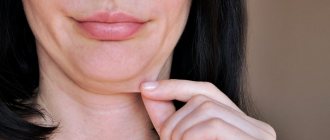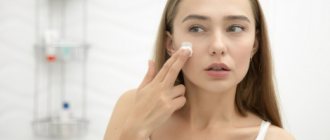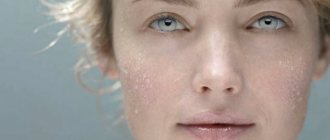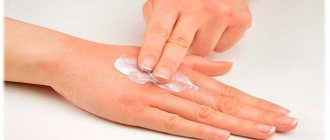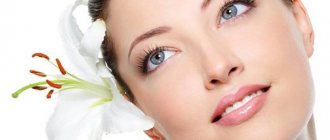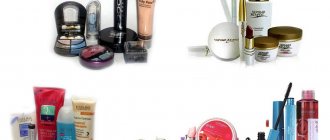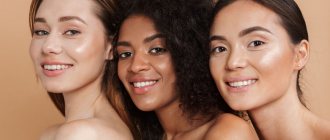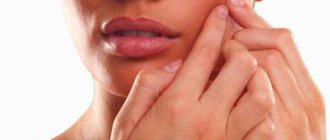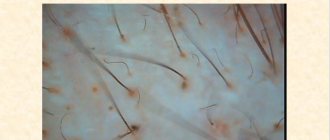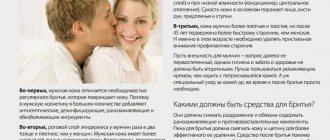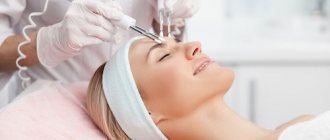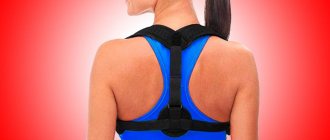Causes and symptoms
Loss of skin tone and elasticity is associated with many factors, including:
- age;
- stress;
- bad ecology;
- lack of vitamins and minerals;
- unbalanced diet;
- lack of hydration;
- presence of bad habits;
- incorrect selection of care products;
- lack of physical activity;
- genetic predisposition;
- hormonal changes in the body.
The collagen contained in it is responsible for the elasticity of cells. Over time, collagen becomes thinner, cell renewal slows down, and the skin becomes thinner, causing wrinkles and folds to appear.
External manifestations of loss of elasticity are expressed in the appearance of wrinkles, enlarged pores, and age spots. The skin loses its healthy color. It slowly returns to its original shape when pulled back. It is impossible to stop this process completely, but with the help of proper care and cosmetic procedures it can be slowed down.
Material and methods
To identify and describe various morphotypes of aging, we developed a questionnaire consisting of four blocks of questions that revealed information about heredity, morphometric data, clinical signs of aging, self-assessment of the condition of the skin and soft tissues of the hands. A 10-point rating system was used, in which the significance of a feature was determined from 0 to 10 (with explanations). The questionnaire was filled out by the patient and an independent medical expert. Filling out the questionnaire took about 5 minutes.
We also collected information about hand dominance at work, profession, preference for using the right or left hand, calculated BMI, and determined the morphotype of aging in interviewed individuals over the age of 40.
At the Vallex Med clinic, from November 2014 to November 2016, a study was conducted in which 310 healthy women of the Slavic type who were cosmetology patients took part. Questionnaires and questionnaires for the subjects were approved by the ethics committee of the Vallex Med clinic.
Inclusion criteria: healthy women aged 25-65 years of Slavic type, I-III phototype, with a BMI of 18-30 kg/m2.
Exclusion criteria: skin, rheumatic diseases, gout, deforming arthritis, various types of injuries to the hands (burns, fractures, scars in the hand area, neurovascular disorders), previously performed cosmetic procedures in the area of the back of the hands.
Standard photography of both hands was performed in oblique radial and dorsal projections in full size, as well as from above during flexion, in the same room with constant temperature and lighting, with the same camera. The photographs were assessed by the same expert (cosmetologist) using the merz scale.
The photographs were assessed and the dominant signs of aging for each participant were identified.
Subjects were weighed and height measured to determine BMI. Next, we measured the length and width of the brush; wrist circumference. Information was collected about the dominant hand, the time of appearance of signs of aging in the area of the back of the hands, and the hereditary nature of skin aging in this area.
At the next stage, the severity of contouring of veins and tendons, loss of volume of the pancreas, and pigmentation were assessed.
The most standard options for aging brushes were selected, and trends in brush aging were determined from photographs.
Test to determine wrinkles and sagging.
The patient's skin was gathered into a fold in the center of the back of the hand (above the area of the third finger) in the longitudinal and transverse direction (pinch test). They raised it above the level of the back of the hands and measured the time during which the skin returned to its original position, and also measured its thickness using a caliper with an accuracy of 0.2 mm.
Treatment
In a medical setting, a set of procedures aimed at caring for the skin of the face and body is selected individually.
Effective medical rejuvenation procedures are as follows:
- Mesotherapy is the subcutaneous administration of vitamin cocktails and other drugs beneficial to the skin.
- Biorevitalization – saturation of the deep layers of the skin with hyaluronic acid.
- Also, high-quality care is provided by peeling procedures, massage, etc.
Our cosmetologists will tell you how to choose the right skincare products and show you facial exercises that can slow down skin aging.
Review of products to improve facial skin tone
In order not to spoil the results of self-massage and gymnastics, you also need to reconsider your lifestyle, habits, and cosmetic care.
Basic recommendations can be found above, in the chapter “Prevention of loss of elasticity in facial skin.”
A few more tips on choosing cosmetics.
- Cleansing
You should cleanse your facial skin in the morning and evening. From dirt, excess fat, cosmetics. The product should be soft, and ideally also moisturize.Hydrolates – plant distillates – are perfect for this. They remove everything unnecessary from the face well and at the same time provide optimal water balance. You can wipe your face with cotton pads soaked in hydrolate several times a day and not be afraid of drying it out. Such products are suitable not only for cleansing, but also for toning and moisturizing the skin.
Depending on your skin type, you can choose mint, lavender or sage hydrosol from Beauty365 at www.beauty365.ru.
- Anti-aging care
To increase skin elasticity, you need anti-aging cosmetics. A rich cocktail of vitamins and fatty acids, beneficial for youth, contain natural products: oils, squalane, balms.For morning care it is better to use squalane. These are light oils that absorb quickly and leave no residue.
Before going to bed, you can afford a more powerful product: oil or balm.
In the Beauty365 assortment you will find squalane (sugar cane), coconut oil, camellia sasanqua oil, Verbena hemp balm (oil and oil extracts of hemp, coconut, shea butter, pistachio, calendula, carrot seeds).
All these products have a rejuvenating effect. They promote moisture retention, nourish, protect, fight free radicals, and activate cell regeneration. In combination with exercises, they increase skin elasticity.
Different Beauty365 oils have their own nuances. For example, Beauty365 coconut oil is better suited for those with dry and sensitive skin prone to irritation and inflammation, and in case of oily skin it should be used with caution. Beauty365 camellia sasanqua oil also works with skin color: it fights age spots and helps prevent the appearance of freckles during the season.
Go to www.beauty365.ru, study the description of Beauty365 products and choose “your” product.
At the same time, you can purchase a Beauty365 dry face brush and Beauty365 glass jars. The most effective way to use squalane and oils is before a vacuum massage or after a dry one.
Prevention
Only regular, properly selected procedures and care products can keep the skin elastic.
In addition to procedures from a cosmetologist, you need to take care of your skin at home: select high-quality cosmetics, regularly moisturize your skin, give yourself a massage and exercises.
It is also important to lead a healthy lifestyle: give up bad habits, walk in the fresh air, get enough sleep, eat right, take vitamin and mineral complexes.
Cosmetologists remind that the sooner you start caring for your skin, the longer you will be able to keep it young, beautiful and elastic. You can make an appointment in St. Petersburg by phone or through the form on the website.
results
Individual hand dominance and preference for using the right or left hand were also analyzed. In 304 (98%) women, the right hand was dominant, in 7 (2%) the left hand was dominant.
300 (96.5%) women preferred to use the non-dominant hand, which is more aesthetically pleasing. Since the dominant hand is used mainly for physical labor, it can be expected to age at an accelerated rate. When surveyed, the majority were aware that hands differ in appearance, but most did not attach any importance to this. In the hand of the dominant hand, congestion, veins, and muscles were more pronounced, and the shape was more reminiscent of a square.
Women placed more importance on the aesthetic appeal of the non-dominant hand.
Among the proposed eight signs that define an “aging hand,” patients identified four main ones: age spots, contouring of veins and tendons, sagging/wrinkling, thinning of the skin (in 87, 84, 78 and 76%, respectively).
In this study, a group of women over 40 years of age was identified ( n
=208) with signs of chrono- and photoaging, three main
morphotypes of aging
of the dorsum of the hand were identified, correlated with age, BMI, and fold thickness (Fig. 3).
Rice.
3. Morphotypes of hand aging. The morphotype of hand aging is a set of constitutional and age-related features of the dorsum of the hand, including shape-forming characteristics, involutional changes in the skin, the severity of subcutaneous tissue atrophy, visualization of veins and tendons.
Type I - atrophic/asthenic morphotype
(31%,
n
=134) occurs in women with an asthenic type of constitution and a BMI of 18-19 kg/m2 of veins and tendons. The skin fold of the dorsum of the hands is thin (1-2 mm), the skin is thinned, dry, wrinkled, subcutaneous fat tissue (SFA) is poorly developed. With the pinch test, the skin straightens out in 4-8 seconds. The circular folds in the wrist area are thin and shallow. The longitudinal size of the rear of the hands, as a rule, prevails over the transverse one, the phalanges are long or of medium length.
In this type, patients with venous and tendon components can be distinguished.
Venous component
very pronounced (for a correct assessment of the filling of the venous network, the study subjects were seated vertically, with the arm bent at the elbow joint at an angle of 90°).
Characteristic is the tortuosity of the vessels, which increases with age, and incomplete emptying of the veins is observed during flexion of the fingers.
During the survey, we found that 45% of women do not associate veins with age. Flexor tendon contouring and venous tortuosity (venotendinous subtype) have been found to be genetically determined; Features of the back of the hand attracted attention already at a young age and were found in the mother. This subtype in our study was identified only in 7.9% ( n
=8).
During the survey, many women noted that the pattern of the dorsal veins changes little with age. The severity of the veins increases from physical activity, after wearing heavy objects, and also due to the characteristics of the profession (the hands of a pianist, violinist, waitress, cleaner).
It was noted that atrophic changes in the tissues of the dorsum of the hands with contouring of the tendons occur closer to the metacarpophalangeal joints.
Tendon component
: tendons are visible on the back of the hand, especially clearly visualized above the center of the metacarpophalangeal joints of the II-IV fingers, especially noticeable during flexion. A direct correlation between the progression of the degree of aging and age was revealed.
Type II - normotrophic morphotype
(48.1%,
n
= 154) occurs in normosthenics with a BMI of 19-24 kg/m2, less often in asthenics. The skin is thin, the skin fold is of medium thickness (2-2.5 mm), with a pinch test it straightens out in 5-7 seconds. The pancreas is moderately developed. Veins and tendons are poorly or moderately visualized. The venous component is often due to genetic or occupational characteristics. During flexion of the fingers, the dorsal veins are completely emptied. With age, multiple transverse flexion folds over the proximal interphalangeal joints (PIP) and a separate fold over the distal interphalangeal joints (DIP) may occur. The circular folds of the wrist are more pronounced. The longitudinal and transverse dimensions of the rear of the hands are close or the longitudinal one slightly predominates, the phalanx is of medium length.
Symptoms of sagging, dry skin, according to our observations and according to patient complaints, appear and progress after 50 years. It is the deterioration of skin quality due to a decrease in its visco-elastic properties that worries patients with this type of aging of the hands.
Type III - hypertrophic morphotype
(20.4%,
n
=23) occurs in women with a hypersthenic build, with a BMI of 25-30 kg/m2. The subcutaneous fat layer of the dorsum of the hands is also well expressed both on the face and torso. The skin fold is difficult to grip and its thickness is above average (2.5-4 mm). The fold quickly (within 3-4 s) returns to its original state, completely straightening out. In the hands of overweight people (BMI>27 kg/m2), there is more superficial fat in the dorsal superficial plate, which masks veins and other deep structures.
Veins and tendons are practically not visualized. Multiple transverse flexion folds over the PIP and a single fold over the DIP may occur. The back of the hands is characterized by a square shape, the phalanges are short or medium in length.
Wrinkles are weakly expressed and dynamic in nature.
Patients of this type of hand aging are the least likely to seek cosmetic treatment for this area. To restore skin moisture and elasticity, short courses of biorevitalization with stabilized hyaluronic acid preparations can be recommended. Fillers are not recommended for this type.
We noted that signs of photodamage to the skin (dullness, pigmentation, lentigo) occur in all identified types of aging. Their number increases with age and does not depend on BMI; they correlate with age and photoaging of the face (see Fig. 3). The number of age spots increases with age (high positive correlation coefficient). Single age spots may first appear in the fourth decade; later they merge with each other, increasing in size and number. After 60 years, the spots are quite numerous (Fig. 4).
Rice. 4. BMI and stage of aging.
Clinical differences in morphotypes of aging hands are presented in the table.
Clinical differences in morphotypes of aging hands Note. + - mild degree of severity of the symptom; ++ - average degree; +++ - pronounced degree.
Thick and thin skin
Skin is usually divided into thick (on the palms and soles) and thin (on the rest of our body). With calluses, thick skin can reach a thickness of almost half an inch (13 mm). The thin skin ranges in thickness from about 0.5 mm on the eyelid to almost 2 mm on the back (1 mm is about the thickness of a penny). The skin is made up of three main layers called the epidermis, dermis and hypodermis. Each of these layers performs its own vital functions.
Three layers of skin
Most of our body is covered with skin called thin skin. It consists of special cells (above) that are designed to die and lock together into precisely spaced columns (below). Each cell is tightly connected to its neighbor by more than a hundred small "point seams" called desmosomes, which give the skin its amazing strength.
Dermis - second layer of skin
"Leather" body
Figure 3 . Thick skin is made up of thicker cells and protects all parts of the body from wear and tear. The dermis, which lies directly below the epidermis, is made up of very strong fibers of a protein called collagen. Collagen fibers are exquisitely woven into a very complex tissue, which in animals such as cows, serves as our source of skin (meaning the one we use to make clothes, things, etc. ed.).
The dermis determines much of the skin's strength and is highly resistant to tearing. Although the dermis must be strong, it must also be elastic and flexible to allow us to move comfortably. Although collagen fibers themselves are very inelastic, the way they are woven allows the skin to stretch like a double jersey.
Special elastic fibers woven through the dermis help restore stretched skin back to its relaxed state, like the elastic waistband of underwear.
"Radiator" of the body
Figure 4 . Heat regulation through capillariesAnother important function of the dermis is to regulate our body temperature. When our body becomes too warm, the heat in our blood must reach the surface of the skin so that it can dissipate into the air.
To control how much heat reaches the surface, blood vessels in the dermis have valves that can divert blood into smaller vessels (capillaries) at different levels of the dermis (Figure 4). Under the control of the brain, blood is diverted to fill these capillaries and dissipate heat. Heat regulation is further supported by sweat glands that pass through the dermis and epidermis.
We have about three million sweat glands in our skin, which can produce up to three quarts of sweat per hour. Sweat, which is mostly water, evaporates from the surface of our skin, giving a cooling effect.
The second layer of skin, the dermis, is filled with a complex network of blood vessels and valves. They allow the body to divert blood near the skin to release heat and cool the body. Many loops increase the surface area, like an efficient radiator.
Conclusion
God's handiwork in creation is evident in everything He has made, even in our skin. Like many things, we take the skin's protective functions for granted. But let's thank God for our skin, which is so important to our lives. First of all, let us give thanks to our Lord and Savior, who forgave those who plunged the crown of thorns into the skin of His forehead and tore the skin of His back to shreds. By His stripes we are healed from sin, death and hell (1 Peter 2:24).
“And I know that my Redeemer lives, and on the last day He will raise this decaying skin of mine from the dust, and I will see God in my flesh. I will see Him myself, my eyes, not the eyes of another, will see Him..." (Job 19:25-27)
